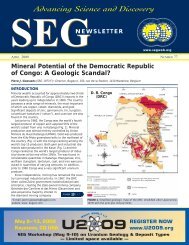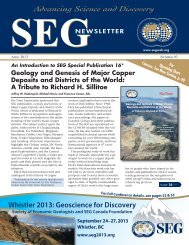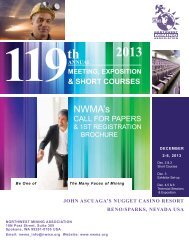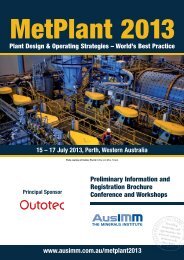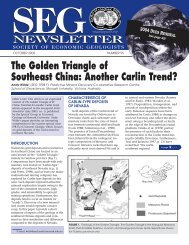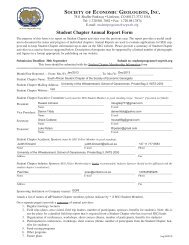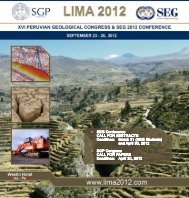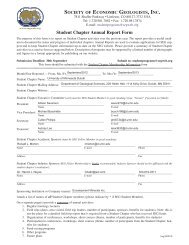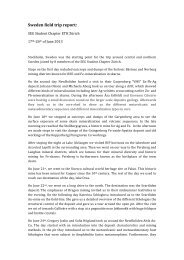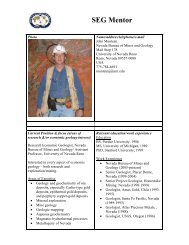SEG - Society of Economic Geologists
SEG - Society of Economic Geologists
SEG - Society of Economic Geologists
You also want an ePaper? Increase the reach of your titles
YUMPU automatically turns print PDFs into web optimized ePapers that Google loves.
22 <strong>SEG</strong> NEWSLETTER No 90 • JULY 2012<br />
<strong>SEG</strong> NEWS<br />
<strong>SEG</strong> GEOMETALLURGY FORUM<br />
Geometallurgy – The Journey<br />
A lot <strong>of</strong> what we do in our pr<strong>of</strong>essional<br />
careers is about project. Projects are<br />
great. They have a start, a middle, and<br />
an end. If things have gone as planned,<br />
at the end <strong>of</strong> this process we have<br />
achieved our goals—our targets—and<br />
we can feel happy about a job well done.<br />
Unfortunately, geometallurgy is not like<br />
that. Geometallurgy is a journey or, as I<br />
find myself telling people, “it is a commitment.”<br />
Of course, the geometallurgical<br />
journey can and will be broken into<br />
steps or phases that resemble projects,<br />
but overall, it is one long journey.<br />
The key areas the geometallurgy journey<br />
can be subdivided into are the technical<br />
journey, the management journey,<br />
and the business process journey. It is<br />
worth looking at each <strong>of</strong> these, as they all<br />
relate to the successful integration <strong>of</strong> geo -<br />
metallurgy into the business <strong>of</strong> a mine.<br />
THE TECHNICAL JOURNEY<br />
One <strong>of</strong> the key deliverables from a<br />
geometallurgical program is a forecast<br />
<strong>of</strong> expected production output on some<br />
time basis (such as quarterly, monthly,<br />
or if you have been at geometallurgy<br />
for a long time, weekly basis). The forecast<br />
will be <strong>of</strong> key concentrator outputs,<br />
such as mill throughput, mill primary<br />
grind size, recovery <strong>of</strong> wanted metals,<br />
and concentrate grade. This forecast<br />
will be based on a model interacting on<br />
the block model with expected feed<br />
blocks for that time period. This model<br />
then calculates the expected outputs<br />
based on some independent variables<br />
(such as head grade, mineralogical<br />
make-up, grindability hardness index).<br />
Having made a forecast, we want to<br />
know how good our forecast was. Its<br />
accuracy is calculated by a reconciliation.<br />
We determine the actual throughput,<br />
primary grind size, recoveries, and<br />
concentrate grade for the target period<br />
and compare it with our forecast (actually,<br />
the reconciliation process is a lot<br />
more complex a process than this, but<br />
that is another discussion). We then<br />
determine the error band between actual<br />
results and forecast and decide if that<br />
forecast was good, acceptable, or poor.<br />
Then the process gets repeated. We<br />
do another monthly or quarterly forecast<br />
and reconciliation. Time and time<br />
again we repeat this process because<br />
stevewilliams@geomettech.com<br />
this is essential and this is how we realize<br />
the value in geometallurgy.<br />
At some point in this repeating cycle<br />
we will review our model and our<br />
underlying assumptions in the forecast<br />
(which could be the independent variables,<br />
the domains, or the model itself).<br />
These will be reviewed and if through<br />
our journey to this point we have<br />
learned new things or understood<br />
things better, then we may enhance or<br />
modify some <strong>of</strong> these components.<br />
The models used to make these forecasts<br />
would be expected to evolve and<br />
perhaps be radically recast over the life<br />
<strong>of</strong> a mine. Models designed in a mine<br />
project’s prefeasibility or feasibility stage<br />
<strong>of</strong> development are <strong>of</strong>ten simplistic as<br />
they are used only to forecast annual<br />
production for the feasibility study.<br />
However, it is logical to use these models<br />
or some enhancement <strong>of</strong> them at the<br />
commencement <strong>of</strong> production. Equally,<br />
it is logical to expect that these models<br />
will be refined, enhanced, or changed<br />
over time as more things are learned<br />
about the fundamental geological drivers<br />
for comminution and flotation or leaching.<br />
It is a long way from an acceptable<br />
error band on yearly forecasted production<br />
to achieving the same error band<br />
on monthly forecasted production.<br />
Another area that evolves with time is<br />
the delineation <strong>of</strong> the geometallurgical<br />
domains. Geometallurgical domains are<br />
those zones or areas that have commonality<br />
in some aspects <strong>of</strong> metallurgical performance<br />
(such as recovery and/or resultant<br />
concentrate grade quality). The<br />
domains are made to help us understand<br />
a complex geological system by clumping<br />
together these areas <strong>of</strong> similar types <strong>of</strong><br />
performance. It should also be pointed<br />
out that there will be different geometallurgical<br />
domains for comminution<br />
and for mineral concentration (such as<br />
flotation).<br />
When a geometallurgy program be -<br />
gins, it is impossible to know what and<br />
where these geometallugical domains are<br />
(because it requires that metallurgical<br />
result feedback loop), so inevitably, initial<br />
geometallurgical domains are built<br />
up from the geological domains <strong>of</strong> the<br />
deposit, but with the application <strong>of</strong><br />
some geometallurgical principles. The<br />
geological domain approach is a good<br />
starting place for geometallurgical do -<br />
mains but in evitably the geo metallurgical<br />
domains will<br />
change or evolve<br />
from there as we<br />
carry on through<br />
the mine life.<br />
Typically,<br />
STEVE WILLIAMS<br />
(<strong>SEG</strong> 2010)<br />
with porphyry copper-type deposits,<br />
there are fewer geometallurgical<br />
domains than geological domians. Some<br />
geological domains have very similar<br />
metallurgical performance. Eventually,<br />
these domains will be clumped together<br />
to form the geometallurgical domain.<br />
However, for other geological entities,<br />
this is not the case. For VMS-type de -<br />
posits, the geological domains do not<br />
well capture the flotation complexities <strong>of</strong><br />
these deposits. So, in this case, we may<br />
see the evolution <strong>of</strong> more geometallurgical<br />
domains than geological domains,<br />
as we try to better describe the metallurgical<br />
performance <strong>of</strong> that deposit.<br />
It can thus be seen that the technical<br />
world <strong>of</strong> geometallurgy is a journey,<br />
with future learning leading to evolution<br />
<strong>of</strong> models, domains, and key<br />
assumptions that change with time.<br />
THE MANAGEMENT JOURNEY<br />
Geometallurgy crosses boundaries from<br />
geology to mine planning to metallurgy.<br />
It also touches on areas such as product<br />
quality/marketing, projects, and exploration.<br />
Given this breadth <strong>of</strong> reach <strong>of</strong><br />
geometallurgy, it means that geometallurgy<br />
is a mine management theme.<br />
Specifically, a mine that is implementing<br />
a geometallurgy program cannot<br />
just say that “this is a geology task or a<br />
metallurgy task.” To do so would not<br />
recognize the breadth and value <strong>of</strong><br />
geometallurgy and would inevitably<br />
doom the program to probable failure.<br />
There are a number <strong>of</strong> real management<br />
issues relating to the successful<br />
implementation <strong>of</strong> geometallurgy in a<br />
mine or mine development project.<br />
Some <strong>of</strong> the key issues include the following:<br />
structure, reporting lines,<br />
geometallurgy management, reports,<br />
decision-making, communication, and<br />
language. This list is large, with some<br />
real challenges, and as with any <strong>of</strong><br />
these human issues, particularly as they<br />
relate to change (change management),<br />
these issues are not addressed once and<br />
then resolved. This is a process or a<br />
“commitment”! What is important is to



